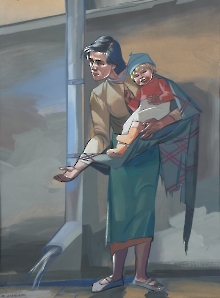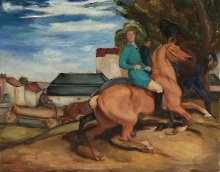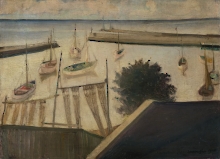On November 11th 1918 the Republic of Poland officially became an independent country again. Although its borders were being shaped for further four years and fights for them were lenghtened by bloody conflicts in its various parts, the restored independence brought the feeling of happiness.
Art – not only the native one – had been preparing for this state for some time. The tendencies of new classicism, strongly felt around 1910, only strengthened their position. The French term rappel à l’ordre and the corresponding Italian term ritorno all’ordine well described the widespread longing for order, stable values and European, national or local traditions. The antiquated costume and idyllic decorations provided a sense of security and the idealised bodies activated defense mechanisms in the event of illness or an "unbeautiful" death.
The need to settle down in the modern world, however, also encouraged the reception of other, extremely various artistic attitudes. Soviet Russia was the source of the utopian promise of changing class structures through the general elimination of "bourgeois" needs: the absolute manifested itself in abstraction and objectlessness. Following the example of artists from the Weimar Republic, the state of ownership was looked at critically, which resulted in meticulous realism or verism of the "new objectivity". In turn, Colourism, a phenomenon with a 50-year history, returned with a wave of modernist historicism and the production of "handy" paintings: petit-bourgeois objects that glorified artistic accessories. Like no other epoch, the Polish interwar period oscillated between two extremes: the crazy 1920s and the pessimism of the next decade, bare calves beating the foxtrot rhythm and the clatter of war invalids' prostheses, allegories of abundance on 20-zloty notes and the problem of unemployment, poverty and hunger in the multinational , multi-ethnic and multi-religious society.
Officially – at foreign art exhibitions, fairs and in tourist guides – the Second Polish Republic shimmered with pure colours of folk costumes and regional crafts. For the chosen ones, modernity meant a ride on a Polish-made motorcycle or a departure from the 147-kilometre long line of the Polish coast on board a luxury overseas ship. Paradoxically, abstract paintings became objectified in the form of cheap utility machine-made glass. However, new models of firearms and gas masks gave a foretaste of the tragedy that came on September 1st 1939. The Second Polish Republic and its allegorical representatives were goddesses, muses, ladies, soldiers, breadwinners and beggars. At our exhibition, which is an announcement of a permanent gallery of modern European art, a female figure was given the role of a guide through the Szczecin collection.
And you take me to the islands of happiness,
kiss and blow my hair like flowers with a calm wind,
lullaby me until I fall asleep with a musical sleep, fog my mind,
don't wake me up from a dream of the islands of happiness.
Show me waters great and calm,
let me hear talks of stars on green tree branches,
show me lots of butterflies, make butterflies hearts come closer to me,
bow peaceful thoughts over the waters with love.
Konstanty Ildefons Gałczyński, Prośba o wyspy szczęśliwe/Crying for Islands of Happiness, 1930
Islands of Happiness?
Art of the Seond Polish Republic from the Collection of the National Museum in Szczecin
The National Museum in Szczecin, ul. Wały Chrobrego 3
December 10th 2022 – March 3th 2024
vernissage: December 9th 2022, 6.00 P.M.
Curator: Szymon Piotr Kubiak, PhD
Organizer: the National Museum in Szczecin
Partner: Szczecińska Energetyka Cieplna
Content, translations and arrangement: Szymon Piotr Kubiak, PhD
Photographs: Grzegorz Solecki, Arkadiusz Piętak
Design: Filip Bylak
Proofreading: Bartosz Zasieczny







